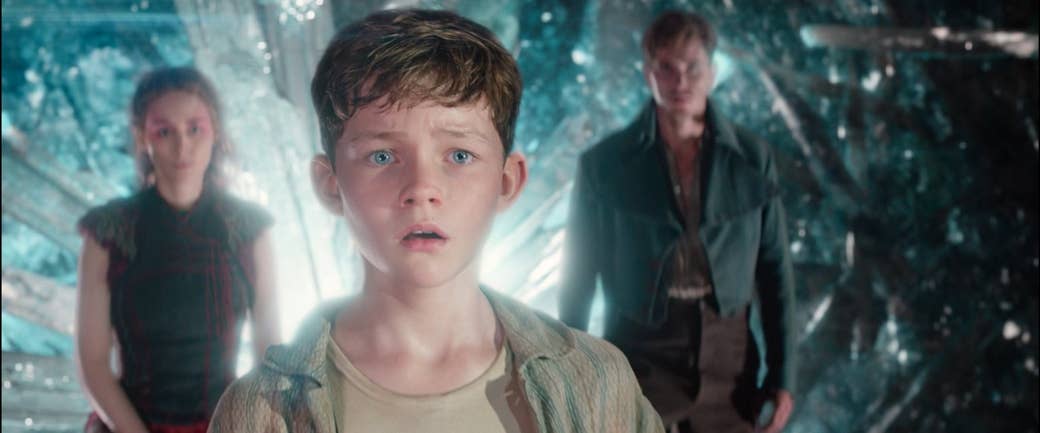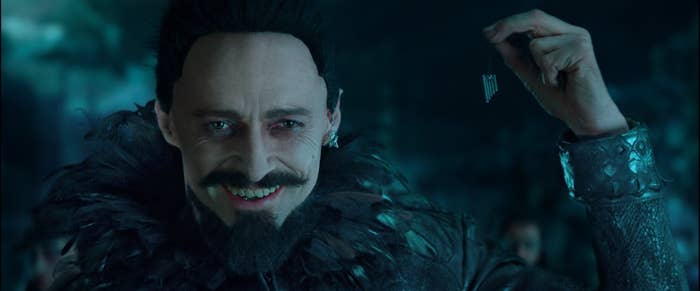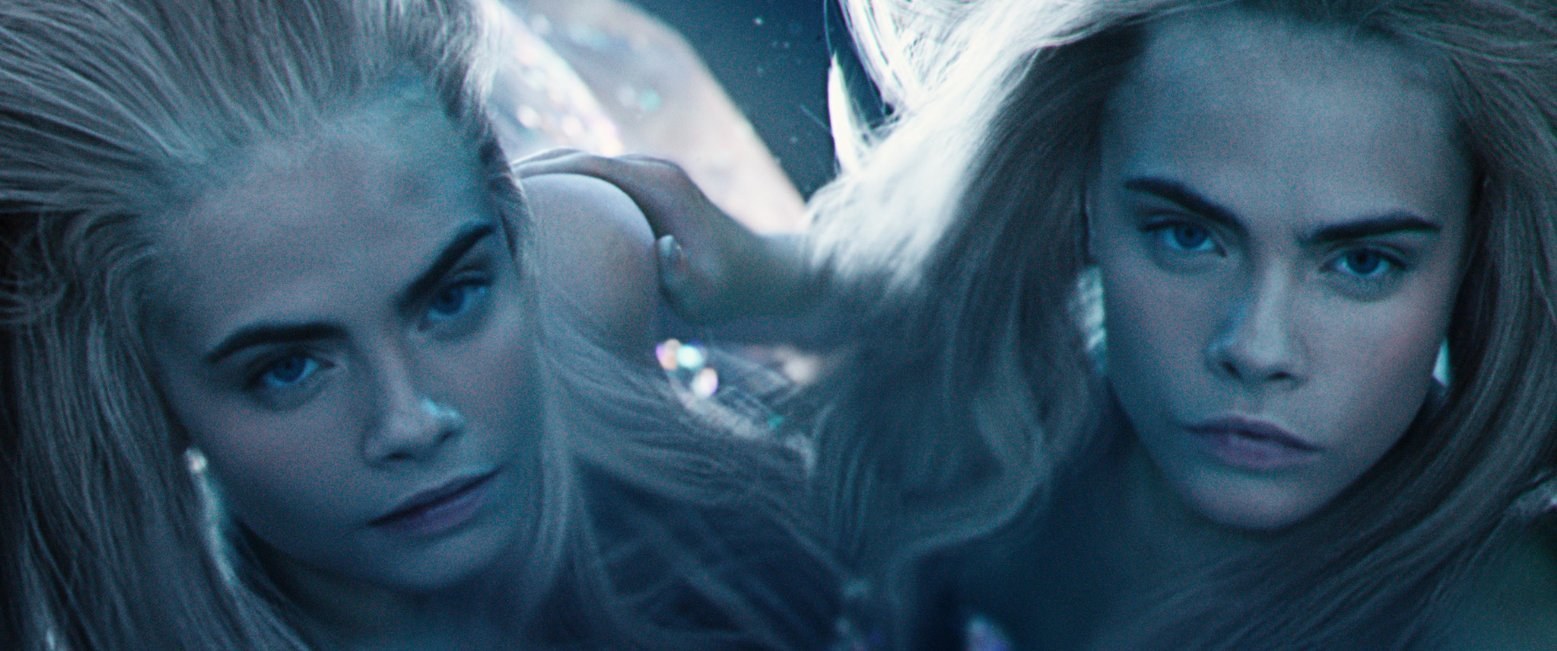
Pan invents an origin story for beloved children's character Peter Pan. Is this something that Peter Pan's creator J. M. Barrie, in his own fashion, has already done? Yup, but his take is inconveniently short on giant airship battles, so fine — it's not like Pan director Joe Wright (Atonement) and writer Jason Fuchs (Wonder Woman) are the first filmmakers to reinvent a familiar property by dredging it in grit like a schnitzel.
They plunk young Peter (Levi Miller) in an orphanage in World War II–era London, where he's mistreated by corrupt nuns and dreams of his mother (Amanda Seyfried) returning to whisk him away. Instead, it's pirates who do the whisking, spiriting him and other kidnappees away in a flying ship to Neverland, where they're forced to toil in the fairy-dust mines under the command of Blackbeard (Hugh Jackman), children working alongside grown men like future villain but current ally James Hook (Garrett Hedlund).
There's nothing revelatory in these developments, but there are bits of agreeable weirdness, like the fact that the ship has to evade the Royal Air Force, or the way that the miners welcome the new arrivals with a round of "Smells Like Teen Spirit." It was the 1940s when Peter left London, which seems a pretty clear indicator that Blackbeard goes on to found Nirvana, and also the Ramones, since later everyone sings "Blitzkrieg Bop."

Jackman plays the “pirate all pirates fear, the original nightmare” like an aging medieval goth with the faint, icky aura of a predator to him — inevitable, given the guy makes a habit of snatching up boys and rewarding their compliance with confectionary. Peter even wakes up in his room, though the movie thankfully never goes that grim. Instead, Blackbeard has pulled the kid aside to tell him about a prophecy.
Oh, a prophecy. Tasked to come up with any sort of backstory to get us to the flying and the crowing and the Lost Boys and the never growing up, Pan goes with what has become default fantasy template No. 1. Peter, we learn, is the Pan, the foretold savior who'll come help the Neverland natives fight the pirates and save the fairy kingdom. He's got a special necklace, and he can fly, and he's the child of a prince and a warrior and if he just believes in himself, he can save the day, etc, etc. He's the chosen one.
Neo in The Matrix is the chosen one. Buffy is the chosen one. Harry Potter is the chosen one. Anakin Skywalker is the chosen one. Heck, Jesus is the chosen one. Why would anyone need to turn a story that is not already about this oft-used concept into one that is? Yet in beefing up Alice in Wonderland into a blockbuster in 2010, Tim Burton and Linda Woolverton took a book about a girl who wandered into a strange dreamscape and made it into a movie about how she's "the real Alice," the only one who can slay the Jabberwocky. Snow White and the Huntsman morphed a story of murderous jealousy into one about a young royal destined to overthrow a despotic queen. And Pan assures its plucky urchin that all along, he's been the most essential person to this magical universe he never even knew existed. Behold: the YA-ification of public domain properties.

What's exasperating about these reimaginings isn't just that they drift into this format like it's the only kind of story worth telling. It's that they feel like they're openly pandering to an idea of what young people like as based on some broad stereotypes about millennials: Kids these days need to be told they're special, so let's make this movie about someone who was born important, even if he or she doesn't know it yet.
These films free their protagonists from having to distinguish themselves by what they do because destiny has already deemed them heroic — they just need to take ownership of the qualities already designated for them. And they imply there was something uninteresting about the characters as they previously existed, as a curious girl, or a young woman on the run, or a forever child.
Pan is a mess in plenty of other ways. Hedlund gesticulates wildly throughout like the host of a children's TV show. In an attempt to make Barrie's outdated Native American racial caricatures less problematic, the movie turns the tribe into this multicultural mishmash of otherness, then appoints white Rooney Mara as their only significant member, Tiger Lily. Callouts to the original Peter and Wendy are so broad and thudding, the actors might as well wink at the camera as they say them. There are mermaids, and, nightmarishly, all of them have Cara Delevingne's face. The final act is an incomprehensible, suspense-free airship tussle over something involving the fairies.

But it's the chosen one–ing of Peter Pan that's the worst betrayal, because Peter Pan as originally written is an ambiguous figure, one who's fled adulthood for the eternal joys of life as an unsupervised boy. He's stuck — he'll never grow up, never have responsibilities or permanent ties, never have romantic relationships, never get past the careless fun of the moment. Wendy Darling goes home and takes the Lost Boys with her at the end of Barrie's story, but Peter stays behind, static, clinging to childhood forever.
In Pan, though, everyone agrees to hang out in Neverland forever. It's home! It's where Peter apparently belongs, and where the hundreds of human traffic victims in the mines are apparently content to stay, since no one mentions them again. There's not a touch of reservation to this decision — Peter even stops by the real world to add to Neverland's numbers, filling out his kingdom with other refugees from adolescence. The grittiest aspect of Pan may be its apparently unintended commentary on pop culture today — having a Peter Pan complex has become something to celebrate, and it's totally fine to never want to grow up.
